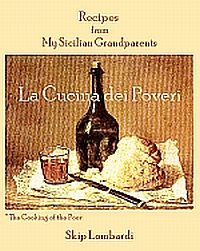Suspect Salep
February 10th, 2010
The 1989 edition of The Oxford English Dictionary cites this 1712 usage of a powdered orchid root used to make a warm winter beverage.
As I write this, Washington, DC has white-out conditions. We know that many of our readers are buried by a blizzard and home from work and school. The novelty of Snowmaggedon may not yet be melting, but we offer a little diversion and something deliciously warming.
This post will lead readers out of the snowdrifts, on a ramble through history via flower-strewn meadows and cinnamon-scented kitchens in the Middle East. Stick with us and you’ll end up with a cup of comfort that has more than a little lore behind it, one that is singularly appropriate for Valentine’s Day.
In Turkey, Iran, and throughout the countries of the eastern Mediterranean, salep has a long been enjoyed as a wintertime beverage—milk boiled with sugar and a very small amount of powdered orchid tuber known as salep. Usually identified as Orchis mascula, though many other terrestrial orchid roots have very similar qualities, salep contains the polysacchyride, bassorin, which swells and thickens a heated liquid in the same fashion as arrowroot or cornstarch. When the hot milk-salep mixture reaches the consistency of a thin potato purée, it is served in cups. Each serving is traditionally dusted with ground cinnamon.
Though people in the Mideast do make the drink at home, connoisseurs seeking a light, warm, liquid meal seek salep in pastry shops or from pushcarts, where it is dispensed from huge brass urns.

Turkish Salepci
The orchid tuber powder itself is nearly tasteless and, in warmed milk, its thickening qualities are not readily distinguishable from other starches. Starches derived from sago, potato, corn, and arrowroot (though not of Mideastern origin) are now widely available and far cheaper than salep, which in its pure state can cost hundreds of dollars per pound. It is for this reason that the instant salep packets most homemakers now buy are so light on salep, with cornstarch and sugar being the primary ingredients.

Yet, packages of most brands still include an infinitesimal amount of the orchid root—or at least they say they do. But why bother? Is this like the whisper of goose liver in tinned patés of pork liver, a trace element of a delicacy lending credibility to the ordinary?
I first gave serious thought to the uses of Orchis mascula two decades ago when I gave a lecture on salep at Oxford. I’ll spare you some of that, but first, a little grounding in ancient Greek and Classical Arabic before we proceed to the recipe for a drink reputed to be a veritable elixir of love.
The word “orchid” stems from the Greek orkhis, or testicle, a reference to the fleshy roots of this family of epiphytes and terrestrial plants. Our subject, Orchis mascula is native to much of Europe and is widespread from the Canary Islands through the entire Mediterranean, Asia Minor and Levant, where I have come to know it as a culinary ingredient.

Orchis mascula
It’s Arabic name is khasyu ‘th-thalab, or fox’s testicles. The th of Classical Arabic tends to become s in popular speech, and salep is nothing more than the word for “fox.” With myriad European spellings, saleb, sahlab, salob, saloop, salub… the beverage was extremely widespread in the 17th and 18th centuries, when fascination and trade with the Levant was especially robust. Particularly prized were the costlier tubers imported from the East.Europeans and the British often made do with those of their own orchids, suggestively classified as “satyrions.”
It doesn’t take much imagination to wonder if plants with such an etymology have had medicinal properties ascribed to them. And indeed they have. From the 3rd century BC writings of the Greek naturalist Theophrastus to a funky 1970 California cookbook on aphrodisiacs to the age of internet searches for “botanical Viagra,” the media abound with the supposed benefits of orchid roots.
The reputation of salep is colorfully inconsistent. Theophrastus’ reports that when mixed with goat’s milk, the tubers will grant prodigious male sexual powers. Victorian writers recommend salep for children and convalescents. From both fabulous and mundane accounts, it is clear that salep drinks were considered restorative; they were even suggested as an antidote to alcoholism.
Local orchids of the British Isles, their roots known as “dogstones,” were evidently abundant and cheap enough to serve the working classes. Salep was deemed a good breakfast for a chimney-sweep. Early in the industrial age, London salep-stalls were plentiful before their eclipse by coffee-shops. Patronized by laborers both late at night and early in the morning, the stalls were places to sober up and gain strength for the day ahead.
At the other end of the social spectrum, Gastronomie Larousse (1961) gives a recipe for potage au salep that can be passed off as the costly delicacy, bird’s nest soup. This gives us a clue as to notions of supply, demand, and celebrity in comestibles. Take two items from the gourmet ingredients list of Chinese cuisine, birds’ nests and shark fins. Both, like salep, add gelatinous texture—but scant flavor—to liquids. And again, like salep, they have been touted as aphrodisiacs. All three are in limited supply (from over-harvesting or destroyed habitats) and are correspondingly costly. As a vintage wine or stamp collector will tell you, rarity plays a part in the appeal of any luxury or collectible and, in the case of aphrodisiacs, helps to sustain their reputations.
I find no discernible difference in taste or mouth-feel between hot salep made with the precious powdered orchid root and faux salep made with cornstarch, the cheapest substitute. As noted, these days, the commercial salep powders are mostly cornstarch with sugar and vanilla flavoring. If you’re an endangered orchid, this should be good news, except that folk-beliefs die hard and if consumers demand genuine orchid roots, wild orchids will continued to be poached to satisfy demand for the aphrodisiac. Turkey, with its extraordinary bio-diversity (over 9,000 different plant species, including at least 148 species of orchids) and vast, sparsely populated areas, is especially vulnerable.
Luckily, environmental awareness and conservation projects are beginning to take hold in Turkey. Projects to employ local inhabitants in the cultivation of endangered orchids and other flora are now underway. Join us there in April and see for yourself.
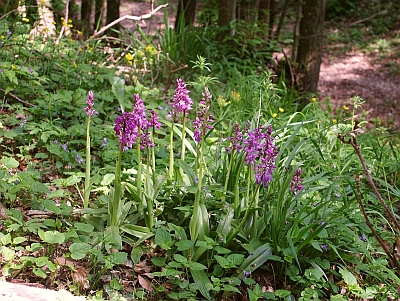
Orchis mascula in the wild
As a Valentine to the country that has taught me so much about food, here’s a recipe for salep and my declaration that NO ORCHIDS WERE HARMED to bring you this post.
SALEP
2 Tbs. cornstarch
4 Cups milk ( whole or reduced fat, but not skim)
3 Tbs. granulated sugar, or more to taste
1 tsp vanilla extract OR 2 tsp rose or orange-blossom water
Ground cinnamon
Into a small prep-bowl, sieve the cornstarch through a tea-strainer to remove any lumps. Stir 5 or 6 tablespoons of the milk into the cornstarch to make a smooth paste. Set bowl aside.
In a saucepan, bring the remaining milk, uncovered, to a boil. Just as it begins to boil, reduce heat to low.
Stir in the sugar and pour in the starch mixture, stirring vigorously, so that lumps do not form.
Cook over very low heat, stirring continuously, until the milk thickens, about 8-10 minutes.
Remove mixture from heat. Stir in one of the flavorings* suggested.
Serve salep in cups or mugs and dust each with cinnamon.
Setting its reputation as an aphrodisiacs aside, the most remarkable quality of salep is the elastic quality it imparts to chilled liquids. (Imagine room-temperature cheese fondue!) Churned from the milk of water-buffaloes, the renowned salep ice-cream of the orchid-rich region of Marash, in southeastern Turkey, has enough body to be hung up on a line, like a damp towel. But that’s a story for another day, one with sunshine and higher temperatures!
Tune in later this spring, after the botanical tour to Turkey that will be led by Sarasota orchidologist, Stig Dalstrom.
Kimchi Confidential
October 7th, 2009Update: October 6, 2010. Today, on their popular Morning Edition broadcast, National Public Radio featured news of a kimchi crisis. NPR’s Asia correspondent reported a serious kimchi shortfall in South Korea– due to a poor harvest season for the requisite Napa cabbage. Our comment ten months ago (see below) that “kimchi…is inexpensive to make…” still holds true for us in North America. Meanwhile, inside Korea, this staple food has soared in price .
Listen here to learn about Koreans’ passion for kimchi, and the sacrifices they’ll make to continue to enjoy South Korea’s national side-dish.
Google KIMCHI, KIMCH’i or KIMCHEE and you’ll not only get recipes for what you thought was merely a pickle, but you’ll learn a lot about how a people defines its national culture through food. The countries of North and South Korea are certainly divided on many issues, but no one disputes that pungent force which is a shared love of kimchi.
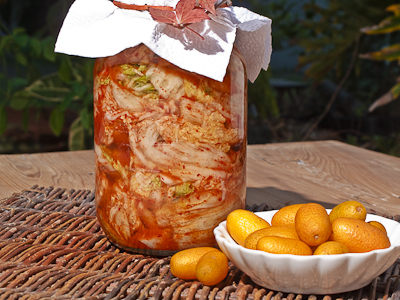
Photo Copyright © 2009, Skip Lombardi
So why, aside from the fact that the most widely-known kimchi sports our holiday colors of red, white, and green, are we writing about kimchi now, two days before Christmas?
Need an almost last-minute gift for the gastronomes on your holiday list?
Slightly fermented Napa cabbage kimchi, not only packs a punch, but it’s quick and inexpensive to make. And at this chilly time of year, even in Florida, you don’t have devote precious refrigerator real estate to shelving it. Just make it and deliver to your lucky recipients. (Then THEY can find a cool place to store it, if they don’t devour it within a day or two.)
So, what if you have NO TIME AT ALL? This staple of any Korean pantry can be bought fresh from our local Korean shop in Gulf Gate. Better still, the shop sells everything—including the cabbage—that you need to make kimchi yourself, so that you can adjust the levels of salt, fermentation and chili-heat, as well as the other seasonings, to suit your own taste. If you do make it yourself, just be sure you allow at least 12 hours to wilt the cabbage before you intend to pack it into jars.
Kimchi can be made from scores of different vegetables, fruits, wild greens, and even seafood. Online, you’ll discover hundreds of recipes—in English, Korean, and several other languages.
Today, we offer our very basic kimchi simply as an antidote to all the sweet gift food that floods our larders in late December:
Napa Cabbage KIMCHI
One large head of Napa cabbage (approximately 4 pounds)
Salt (at least 1/2 cup)
8 kumquats or 1 large lemon (optional)
1/4 lb fresh, firm ginger-root
4 scallions (including green tops)
6 cloves of garlic, sliced lengthwise in thirds
2-3 Tbsp Asian fish sauce (such as nuoc mam)
1/2 tsp dark sesame oil (optional; it adds a smoky flavor)
1/4-1/2 Cup Korean-style coarse red pepper flakes; medium heat (or to taste)
Remove and rinse any loose, outer leaves from the head of cabbage. Squeeze them out and pat them dry with a kitchen towel. Trim off and discard any discolored parts of the leaves or the full head. With a large, sharp knife or cleaver, cut the loose leaves into large pieces and quarter the entire Napa head lengthwise. Cut each quarter across into thirds.
Separate the leaf chunks into a very large, non-reactive bowl and mix with the salt—by hand or with 2 wooden spoons—so that each piece of leaf has a gritty coating of salt. Cover the bowl with plastic wrap and let it sit in a cool place for at least 12 hours.
Assemble a few large, clean, lidded glass jars and a roll of plastic cling-wrap.
Uncover the bowl. The leaves should be wilted and greatly reduced in volume. Pour off and reserve any accumulated liquid. Take handfuls of the leaves and squeeze them to release more liquid. Pour that off and add to the reserved liquid.
Slice the kumquats in half and remove the seeds.
If using a lemon, remove any seeds and slice into thin half-moons.
Julienne the scallions into match-stick lengths.
Rinse and slice the ginger into dime-sized pieces (no need to peel it).
Toss the sliced garlic with all the ingredients above and then add the chili pepper and a few drops of sesame oil. Toss the leaves so that they are evenly coated with the chili flakes.
Using a pair of tongs, begin to pack a jar with the leaves, pressing them in so that there is little room for air. For aesthetics, try to put a a few pieces of kumquat or lemon and the brighter green leaves and scallion tops towards the outside of the jar. Pack the jar firmly with cabbage to within 1/2 inch of the top. Repeat with another jar until you have used all the cabbage mixture.
Taste the reserved salty water poured off the wilted cabbage. If you find it pleasantly salty and a little tangy, great; you can use it as it is. If it is unpleasantly salty, dilute with up to one third plain cold water until YOU like the taste. Now, pour some of this liquid back into each jar, pressing down the cabbage to release any air pockets.Be sure that all the contents are covered with liquid and nothing is floating to the top of any jar.
Cut a double square of plastic wrap and place it over the jar opening so that it covers it completely and extends an inch beyond. Place lid over the plastic wrap and secure tighly. ( If you need an instant hostess gift, you could give the kimchi away at this point, but it is better to wait another 12-36 hours.) Read on….
Put the jars on a non-reactive tray or plate and let them sit at room temperature for at least 12 hours. The contents will begin to ferment and the liquid may rise and leak from the top of the jars, collecting on the tray. If the smell bothers you, simply rinse off the jars and tray as the liquid collects. After 24 hours, open one jar and remove a little of the cabbage to taste. If you like what you have, slow down the fermentation by refrigerating the jars. (It’s a good idea to keep a saucer under each as long as the jar is full.) If you prefer a more sour flavor, allow the fermentation to continue at room temperature. Keep tasting until you reach a balance of salty and sour that pleases you, then refrigerate the pickle.
Serve as a condiment with grilled poultry or meat. A few spoonfuls of kimchi will transform a bowl of steamed rice or Asian noodles.
Change?
September 23rd, 2009We don’t dine out often, but now that the summer crowd has left, we’ve treated ourselves to a few meals at local restaurants. My guests and I are all good cooks, and what we usually choose to prepare at home is different from the restaurant menu dishes that we sometimes crave. Perfectly battered, deep-fried seafood and stuffed squash blossoms are tricky at home, and we’re happy to patronize casual places that serve these delectations. Besides,once in a while, it’s nice to let someone else clear the table.
But the demeanor of our servers marred the experience of our two most recent restaurant meals. On both occasions the issue was one of etiquette. In each restaurant, I’d placed more than enough cash on the table to cover the register receipt for a meal we’d just enjoyed. And each time, as our server picked up the cash, she asked, “D’ you want change?” In both instances, I felt I’d just been deprived of a satisfying meal.
At one restaurant, the change due from our lunch tab would have topped thirty percent. At the other, the remainder would have been barely six percent. Of course, I have to ask myself if the servers’ expectations might also have been different. Perhaps our fellow luncheon patrons—many of whom sported hair-gel and gold chains—were lavish tippers. At the other, a burger-and-fries sports bar, our very young server (who might have just moved up from washing dishes) could have considered six percent to be just fine. We may never know.
Nevertheless, I’m thinking that in the future I might bring a little tent-sign to put on my table. It would say something like “Change is good.” or ” Caution: Tipping Point! ”
Several years ago while waiting for a European flight at JFK, I ordered a couple of beers for myself and my travelling companion at a bar in the passenger lounge. When our server presented our drinks, I handed her a ten-dollar bill for two three-dollar beers. Smirking, she said, “You don’t want change, do you?”
I was as appalled then as I am now, but back then we just chuckled and said, “Ahh, that’s why we love New York…” Back then, it made a good story. But now, it just seems coarse.
I hereby give notice to restaurateurs: We’ve passed the autumnal equinox, and it’s time for a little seasonal shape-up. The days are shorter, the nights crisper. Change is in the air.
Oranges, Sicilian-Style
January 18th, 2009Arance alla Siciliana
ah-RAHN-cheh AH-lah see-chee-lee-AH-nah
No, it’s not a movie about Sophia Loren and the CFO of Tropicana…
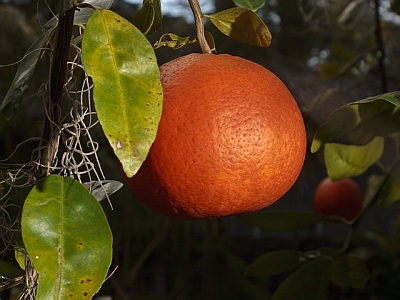
Copyright © 2009, Skip Lombardi
It’s a recipe.
And this time, we couldn’t decide on which of our two food blogs it should appear…
A delicious example of how the simple treatment of seasonal ingredients is usually superior to more labored presentations, Arance alla Siciliana are certainly Italian… Ours this week, just happen to be Floridian; in fact, Sarasotan.
As a starter, side, or dessert—the dish is instensely flavorful, just the the thing after too many weeks of feasting. At the same time, it’s a good use of the local ingredients we like to salute. We made ours right here, with the unsprayed, benignly neglected fruit from our back-yard trees. We grew the mint, too.
So we invite you to see the full recipe and story of Arance alla Siciliana, Oranges Sicilian-Style, on Almost Italian.
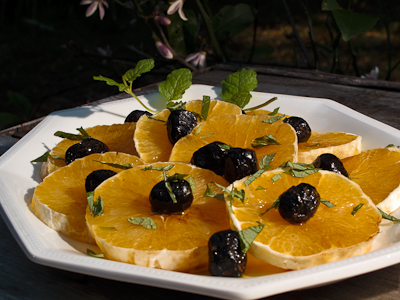
Copyright © 2009, Skip Lombardi
Then, we dare you to serve them at your Superbowl Party. We promise they’ll disappear as quickly as the wings and nachos.


